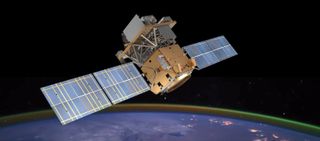China's new solar probe snaps its 1st image of the sun (photo)
The ASO-S observatory captured a solar flare eruption.

China's recently launched Advanced Space-based Solar Observatory (ASO-S) has returned its first image, showing an M-class flare erupting on the sun.
The sun image was produced by the spacecraft's Hard X-ray Imager (HXI) and released by the Purple Mountain Observatory (PMO) under the Chinese Academy of Sciences (CAS).
HXI captured the eruption of a medium class solar flare on Nov. 11, just weeks after ASO-S was launched. The event saw a tremendous explosion of electromagnetic radiation from the sun's atmosphere. These and larger solar flares can affect the ionosphere and radio communications on Earth.
Related: What is space weather, and how is it predicted?

ASO-S, nicknamed Kuafu-1, launched on Oct. 8 into a sun-synchronous orbit about 450 miles (720 kilometers) above Earth, from which it will monitor the sun's magnetic field and observe solar flares and coronal mass ejections, which hurl vast quantities of superheated plasma into space.
The probe aims to further our understanding of how these violent events are generated and improve space weather predictions.
HXI and ASO-S's two other science instruments have been tested and calibrated, and the probe has already started its operational science phase.
Get the Space.com Newsletter
Breaking space news, the latest updates on rocket launches, skywatching events and more!
Follow us on Twitter @Spacedotcom or on Facebook.
Join our Space Forums to keep talking space on the latest missions, night sky and more! And if you have a news tip, correction or comment, let us know at: community@space.com.

Andrew is a freelance space journalist with a focus on reporting on China's rapidly growing space sector. He began writing for Space.com in 2019 and writes for SpaceNews, IEEE Spectrum, National Geographic, Sky & Telescope, New Scientist and others. Andrew first caught the space bug when, as a youngster, he saw Voyager images of other worlds in our solar system for the first time. Away from space, Andrew enjoys trail running in the forests of Finland. You can follow him on Twitter @AJ_FI.
